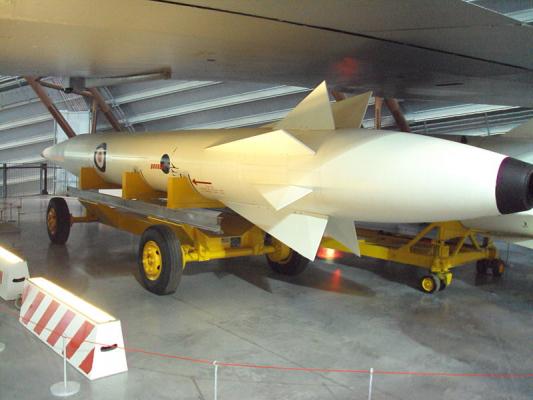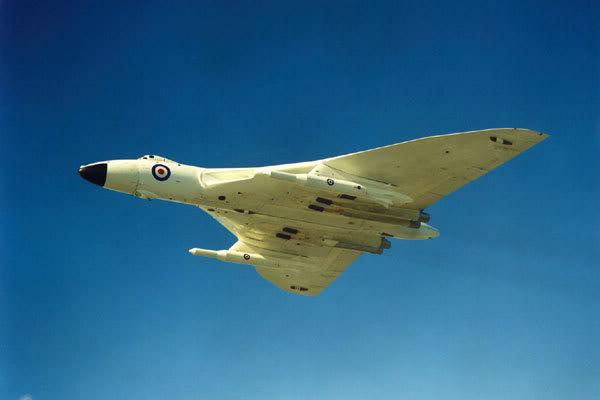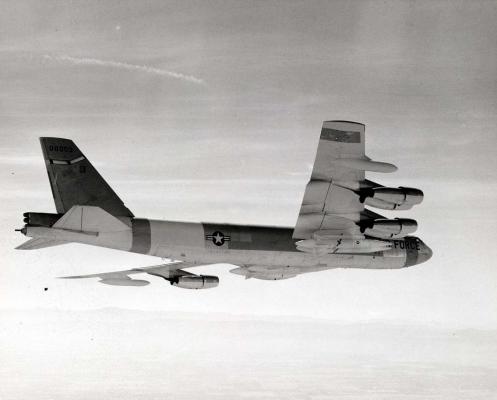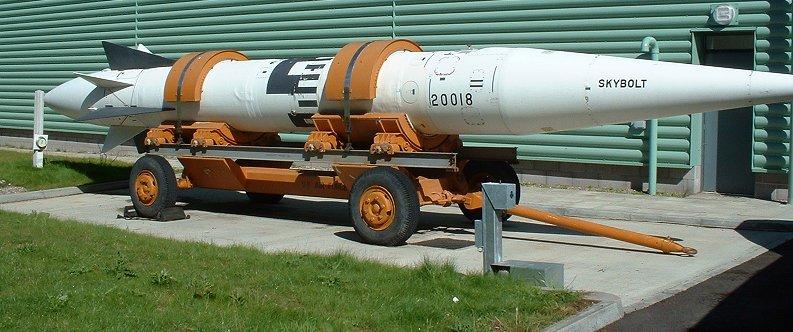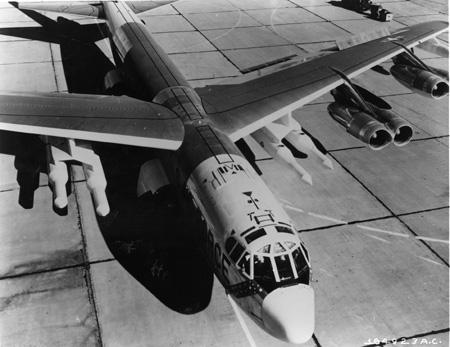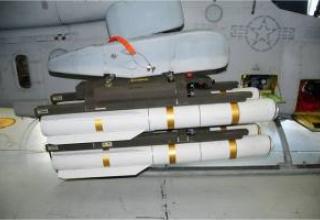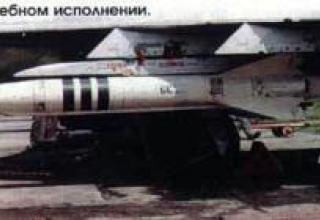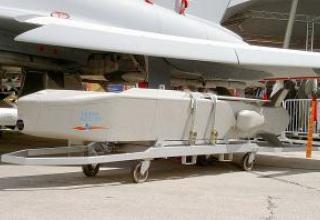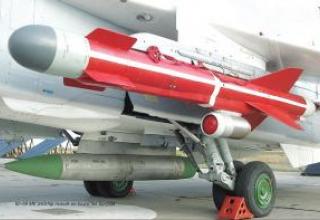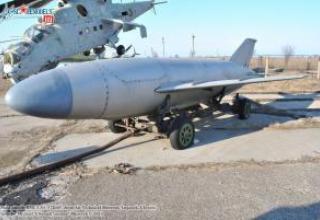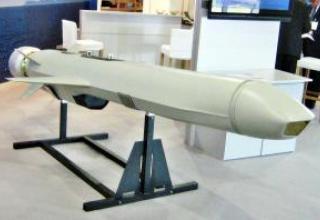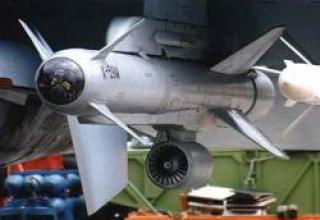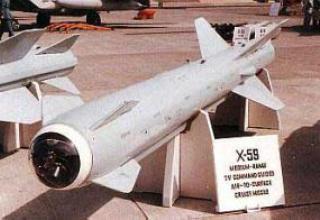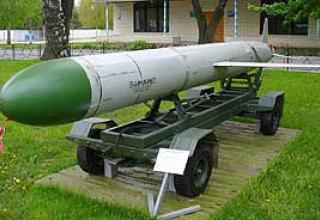The history of Skybolt BR is closely linked to the discussion that took place in the late 1950s in the United States. The subject of the discussion was the problem of increasing the probability of a retaliatory strike by the US strategic nuclear forces in connection with the appearance of intercontinental ballistic missiles in the USSR. At that time, the basis of U.S. strategic nuclear forces was formed by strategic bombers, the most advanced of which were B-52 Stratofortresses of various modifications. However, it became clear that increasing the altitude and speed of a manned nuclear weapon carrier in the future would not ensure its survivability due to the intensive development of anti-aircraft missile systems.
One of the simplest exits was to equip aircraft with heavy missiles with thermonuclear warheads, with which it was possible to destroy the most important targets without entering the zone of action of air defense means. The first ICBMs (Atlas and Titan I), although they lacked the means to intercept ICBMs at the time, had a number of serious shortcomings: the oxidizer (liquid oxygen) did not allow ICBMs to remain on alert at all times and posed problems with storage safety and rapid missile deployment; the small number of missile positions occupied a large area and were vulnerable to a sudden enemy strike; and, most importantly, the number of U.S. first-generation ICBMs was, according to analysts, extremely small for reliable support of a strategic offensive. Bombers equipped with long-range missiles, though vulnerable on the ground, seemed to military experts at the time virtually invulnerable in the air, operating from numerous U.S. bases around the world, covered by fighter jets and provided with refueling aircraft to replenish the air. The number of bombers in the U.S. Strategic Air Command was growing year by year - by 1959, the number of only the latest B-52 Stratofortress strategic bombers of all modifications was 380. By 1960, their number had increased to 488 and continued to grow, reaching a maximum of 639 by the end of 1962. In addition, according to supporters of strategic aviation, it, in comparison with other means of delivery, had sufficient flexibility in the choice and correction (including in flight) of the application tasks. First-generation ICBMs did not possess this capability and were not distinguished by their accuracy; their range of fire did not allow them to engage all targets in the USSR.
Based on the consideration of all the above factors, January 22, 1959 the U.S. Air Force General Headquarters issued General Operational Requirement -GOR 177 (General Operational Requirement -GOR 177) for the development of a strategic ballistic missile air-to-ground class, the carrier for the new missile was to become a strategic bomber B-52. Later on, the missile was called Skybolt. On May 26 of the same year, the U.S. Air Force Headquarters signed a contract with the Douglas Aircraft Company as the main contractor for the in-depth development of the Skybolt missile. Also corporations received contracts: Northrop for the development of the control system, Aerojet for the development of the propulsion system, General Electric for the development of a combat unit. Direct work began in July 1959 as part of the creation of "weapons system" WS-138A. To apply the new missile Boeing Corporation had to create a modification of the strategic bomber B-52G Stratofortress - B-52H, which differed significantly improved propulsion system, electronics, etc. According to top Air Force officials, this weapon system was to significantly improve the efficiency and survival of the strategic bomber fleet. Thomas D. White, Chief of General Staff of the Air Force, said that this missile will provide strategic bombers with high flexibility of use and far exceed the promising Polaris SLBMs. October 13, 1959 at the Atlantic Missile Range was the last of 12 launches of a pilot air-based ballistic missile Bold Orion. The missile, launched from the B-47 long-range bomber, flew about 1,600 kilometers and confirmed the technical feasibility of a program to develop a promising missile Skybolt, which in the same year was designated XGAM-87A. By mid-1967, the U.S. planned to equip 22 squadrons of strategic bombers B-52 Stratofortress missiles Skybolt, for which they intended to produce 1000 missiles. It was planned to spend $15.3 billion on this.
By this time, the UK had taken a significant interest in the programme. By equipping its long-range V-type bombers (Valiant, Victor and Vulcan) with a promising American missile, it was able to address the vulnerability of national SNF in international conflicts. As a result of a meeting in May 1960 between U.S. President Eisenhower and British Prime Minister McMillan, an initial agreement was reached on the transfer of 144 Skybolt missiles to Britain in exchange for the right to use the Holy-Loch base in Scotland to base U.S. SSBNs. On June 6, 1960, after a week of agreement on all outstanding issues, British Defense Secretary G. Watkinson and his U.S. counterpart T.S. Gates-ml. announced that the U.S. agrees to provide Britain with promising air-based ballistic missiles Skybolt to be placed aboard the Vulcan long-range bombers. The UK had planned to develop thermonuclear warheads for these missiles itself, as the U.S. nuclear safety rules were considered insufficient by the British. Following this statement, the importance of the program for both countries' political leadership increased. Despite this, on December 22 of the same year, the Ministry of Defense postponed the Skybolt program and reduced its implementation due to lack of funding. By that time, however, weighted models of the new missile had already been prepared and in January of the new year 1961 their throwing tests in the United States began with the B-52G bomber. In the UK began flights of specially equipped Vulcan bombers with weight-size mock-ups of missiles on the outer suspension, followed by a fling test of the mock-ups.
By April 1962, the missile was on a flight test. Tests were conducted over the Atlantic Missile Range from a specially modified B-52G bomber. Here the creators of the rocket was waiting for a great disappointment - from the first five test launches conducted from April to November 1962, all five failed. By this time, the Air Force was successfully implementing projects to deploy more advanced than its second-generation ICBM precursors - the Titan II and, above all, the Minuteman IA/B. Polaris A-1 SLBMs were entering service with the fleet, and even more advanced SLBMs and SSBNs were being successfully deployed. For the reasons described above, the U.S. Department of Defense significantly cooled down to the Skybolt program. On November 21, 1962 the Minister of Defense R. McNamara recommended to the President of the USA J. Kennedy to close the Skybolt program as a program "which is not necessary". The program was finally closed in December of the same year, which caused great tension between the USA and Great Britain (the so-called "Skybolt crisis").
Initially, after the program was closed, the U.S. planned to transfer all the technical developments on Skybolt to the UK for a price of $100 million, but the British decided to take advantage of the situation - British Defense Minister P. Tornickroft offered Prime Minister G. McMillan to insist on including the UK in the plan for deployment of American Polaris SLBMs. On December 21, 1962, U.S. President J. Kennedy and British Prime Minister G. McMillan issued a joint statement (the so-called "Nassau Pact") that the Skybolt program would not be implemented. As a replacement, the US agreed to provide the UK with promising Polaris-A3 SLBMs (SSBNs, infrastructure and BCs were to be developed by the British themselves). In the period before the Royal Navy received the Polaris SLBM, the British Air Force was to acquire the so-called "stop-gap weapon", i.e. "temporary" weapon, which was to increase the chances of bombers to break through to the target and destroy it. These weapons were the Blue Steel ALCM and the WE.177B thermonuclear bomb (0.45 Mt, suitable for precise use from low altitudes with delayed blast function).
Ironically, on December 22 of the same year, the last, sixth, test launch of a Skybolt missile prototype was conducted over the Atlantic Missile Range from a B-52G strategic bomber, which proved successful. According to some data, it was the failure of the Skybolt project that became one of the most important reasons for the resignation of the Cabinet of G. McMillan. According to published information, the Skybolt program by the time of its termination was spent about $ 440 million in prices in 1962. On a limited scale, the remaining missiles were used for various tests, including obtaining the necessary data for the development of the missile SRAM (in June 1963, the designation of the missile was changed to XAGM-48A Skybolt).
Composition:
The XAGM-48A missile had an oval body. Inside the casing there were: thermonuclear BC in the detachable combat unit, control system devices, electrical wiring and cables, auxiliary systems, solid fuel engines of I and II marching stages, etc.. The outer surface of the casing was covered with a special heat-shielding rubber-like ablation-type compound, which solved the problem of heat flow removal.
The RDTT of I marching stage developed by corporation Aerojet, had one central fixed partially recessed nozzle. When hanging missiles on the external nodes of the suspension of aircraft carriers on the tail of the missile was attached to a special nozzle, reducing the aerodynamic resistance of the missile at high speed flight on the external node of the suspension. After dropping the nozzle was removed with the help of pyrobolts, during this time the rocket freely "subsided" by about 120 m relative to the level of dropping. The first stage's hull contained four triangular-shaped stabilizers and four all-terrain rudders, which were deflected by the corresponding control system signals. After the completion of stage I RTDT, the spent stage was discarded and the missile was in free flight for some time.
After all on-board systems had been tested with the help of special control system units, stage II RDTT was launched, which was also developed by Aerojet Corporation. This engine was equipped with one deflected central nozzle. Stage II operated until the rocket reached 60 km altitude, after which the fuel supply was exhausted, the spent stage with the control system unit was separated and further flying along the ballistic trajectory continued only the combat unit with thermonuclear BC.
The 1.2 Mt W-59 BC for US missiles was developed by the Atomic Energy Commission. The 1.2 Mt BC for the British RE.179 missiles was developed by the Atomic Weapons Establishment (AWE) in Aldermaston.
The NAS-14 missile control system is astroinertial, developed by Northrop Corporation. It is reported that the experience used in working on this system was used to create the astroinertial control system NAS-21 high-altitude reconnaissance aircraft Lockheed SR-71A Blackbird.
It was planned to use Boeing B-52H Stratofortress strategic bombers specially designed for this purpose as a carrier in the USA. Each aircraft was to carry 4 BRs on the outer sling, 2 under each wing on a special - shaped pylon. In the bomb compartment could be placed Quail trap missiles or free-falling thermonuclear aircraft bombs.
The UK planned to place Skybolt missiles on board its most advanced long-range Avro Vulcan B.2 bombers (28 planes were modified in advance pending the delivery of missiles). Each aircraft was to carry 2 BRs on the outer sling, one under each wing on a special "British" pylon. Free falling thermonuclear bombs could be placed in the bombshell.
Characteristics:
| Weight in gear, t. | 5,0 |
| Length, m | 11,66 |
| Diameter (according to the ends of stabilizers), m | 1,68 |
| Hull diameter, m | 0,89 |
| Range of fire, km | 1850 |
| Maximum flight altitude, km | 480 |
| Maximum flight speed, km/h. | 15300 |
| Stage 1: kerb weight, t length, m diameter, m maximum pull, kN office hours, with |
2,0 7,0 0,89 111,0 100 |
| Stage 2: kerb weight, t length, m diameter, m |
0,8 3,0 0,89 |
Testing:
As of 01.01.1950, the factory batch of 230 shells was completed and sent to the Pavlograd test site.
In November 1949, pre-factory tests of 34 shells were carried out together with the fuse B-377 during which cases of missiles were revealed.
Special tests carried out to determine the causes of deficits showed that the most probable cause was an increased release of unburned reactive charge particles at the end of the active section of the trajectory.
In order to eliminate this phenomenon, in December 1949 a bench-top refinement of the engine was started with regard to aperture enhancement and ensuring that the powder charge was fixed in the chamber. After the end of the bench work and experimental firing for checking the reinforced aperture, the factory batch of projectiles was to be equipped with modified apertures on site and presented for factory tests in February 1950.
Sources:
- To defend and deter: the legacy of the United States Cold War missile program / J.C. Lonnquest and D.F. Winkler. USACERL, 1997.
- Alert operations and the Strategic Air Command, 1957-1991 / SAC HQ Office of the Historian, 1991.
- Strategic Air Command and the Alert program: a brief history / SAC HQ Office of the Historian, 1988.
- SAC Missile Chronology 1939-1988 / by Office of the Historian HQ SAC. OH HQ SAC, Offut AFB, NE, 1990.
- Стратегические бомбардировщики и ракетоносцы зарубежных стран / В.Е. Ильин и И.В. Кудишин. Москва, АСТ Астрель, 2002.
- http://www.strategic-air-command.com/
- http://www.astronautix.com/
- http://www.brookings.edu/
